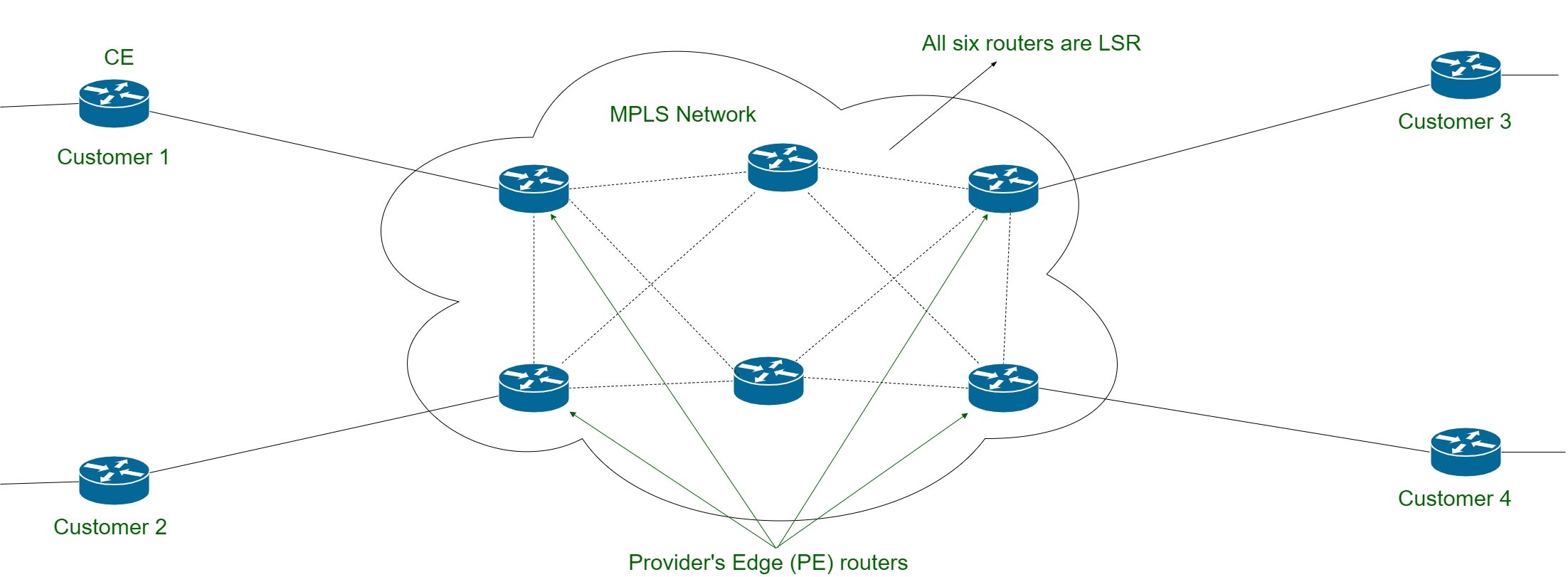How To Set Up Mpls Network
Multi Protocol Label Switching (MPLS)
Prerequisite –
- Working of MPLS
- Deviation betwixt VPN and MPLS
Multi Protocol Label Switching (MPLS) is an IP packet routing technique that routes IP packet through paths via labels instead of looking at complex routing tables of routers. This feature helps in increasing the delivery rate of IP packets.
MPLS uses layer iii service i.e, Net Protocol, and uses router as forwarding device. The traffic of dissimilar customers is separated from each other considering MPLS works somewhat like VPN. It does not work like regular VPN that encrypts the information only it ensures packet from one customer cannot be received by another customer. An MPLS header is added to packet that lies between layers 2 and 3. Hence, it is too considers to be Layer two.v protocol.
MPLS Header –
The MPLS Header is 32 bit long and is divided into four parts –
- Label – This field is 20 bit long and can take value b/westward 0 & 2xx – 1.
- Exp – They are iii $.25 long and used for Quality of Service(QoS).
- Bottom of stack (S) – It is of size ane bit. MPLS labels are stacked ane over other. If in that location is merely one characterization remained in MPLS header, then its value is 1 otherwise 0.
- Time to Live (TTL) – It is 8 flake long and its value is decreased by one at each hop to prevent package to get stuck in network.

Important terms used in MPLS :
| Terms | Clarification |
|---|---|
| Provider Edge(PE) Router | Router at edge of MPLS network that add together or remove label from IP packet. |
| Client Border(CE) Router | Router at edge of customer network that send or receive IP parcel from PE. |
| Characterization Switch Router(LSR) | Routers used in MPLS network that can understand labels. |
| Ingress LSR | LSR routers that receive IP packet from CE Routers and add together MPLS header. |
| Intermediate LSR | LSR routers that bandy label in MPLS header and assigned for forwarding labeled IP packet. |
| Egress LSR | LSR routers that ship IP packet to CE routers and removes MPLS header. |
| Push, Pop and Bandy | Action of addition, removal and swapping of labels past LSR respectively. |
Forwarding in MPLS :
LSRs receive IP packet CE and add an MPLS header in betwixt layer 3 and layer 2 means it encapsulates the link-layer i.e, layer 2 frames. This characteristic allows LSRs to support receiving packets containing frames from different protocols like Frame Relay, Metro Ethernet, etc, that's why information technology is called multi-protocol.
MPLS forwarding is based on characterization attached to IP packet. This label zipper is regulated past protocol called Characterization Distribution Protocol(LDP). Each LSR initially learns routes equally normal routers exercise. This learning starts with PE routers. Each PE router learns routes to different subnets from CE router. Suppose PE router PE1 learns route to subnet (say subnet1) from CE router. Now PE1 volition add together label to packet, forward to its neighboring LSR, and tells them that if you receive packet which destination address to subnet1 then forward information technology to me.
Again this process is repeated by this LSR. In this style, LSR learns routes and add this data in Characterization Forwarding Information Base of operations(LFIB). Now if any PE receives packet with destination to subnet1, so looking at labels and LFIB, LSRs tin easily forward IP packet.

Source: https://www.geeksforgeeks.org/multi-protocol-label-switching-mpls/

0 Response to "How To Set Up Mpls Network"
Post a Comment